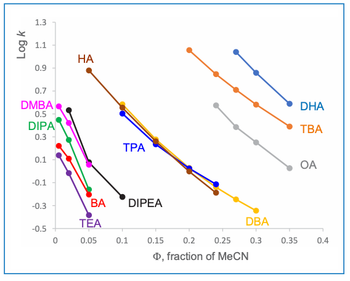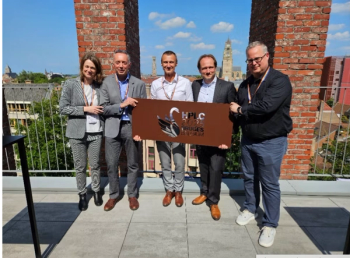
- LCGC North America-04-01-2016
- Volume 34
- Issue 4
New HPLC Systems and Related Products Introduced at Pittcon 2016: A Brief Review

This installment describes high performance liquid chromatography (HPLC) instruments and related products introduced at Pittcon 2016 held in Atlanta, Georgia, or in the year prior. We highlight innovative features and benefits of new HPLC systems, modules, software, and product extensions.
This installment describes high performance liquid chromatography (HPLC) instruments and related products introduced at Pittcon 2016 held in Atlanta, Georgia, or in the year prior. We highlight innovative features and benefits of new HPLC systems, modules, software, and product extensions.
The Pittsburgh Conference on Analytical Chemistry and Applied Spectroscopy (Pittcon) is one of the world’s largest conference on laboratory science. The 68th Pittcon was held at the Georgia World Congress Center in Atlanta, Georgia, on March 6–10, 2016. The last time Pittcon was held in Atlanta was in 2011. Note that Chicago, Illinois; Orlando, Florida; Philadelphia, Pennsylvania; New Orleans, Louisiana; and Atlanta are the cities selected for recent and future Pittcons. Atlanta is a modern city with a rich history as the capitol of the old south and famous as the host of the 1996 Summer Olympics. The conference center is located right next to the 21-acre Centennial Olympic Park. Surprisingly, the city has only half a million residents, although the greater Atlanta area boasts a population of 5.5 million. Atlanta is a world city and home to many big companies, including Coca Cola, United Parcel Service, Home Depot, Delta Airlines, AT&T Mobility, Newell Rubbermaid, CNN, the Southern Company, Georgia Pacific, and the Centers for Disease Control and Prevention.
Pittcon 2016 had nearly 13,000 conferees and exhibitor personnel for the ~2000 presentations, 100+ short courses, and a huge exposition with ~1000 exhibitors. This year’s conference featured a plenary lecture by Nobel laureate William Esso Moerner, and once again provided a premier meeting venue for analytical chemists as well as a global showcase for instrument manufacturers.
Megatrends in HPLC Equipment
2016 appears to be an off year for new high performance liquid chromatography (HPLC) system introductions. With many second-generation ultrahigh-pressure liquid chromatography (UHPLC) systems having been introduced in prior years (1–3), this year’s system introductions were more line extensions than totally brand new systems. Four new systems have dual flow path designs, while two biocompatible systems with quaternary pumps were also introduced.
Table I lists new product introductions (arranged alphabetically by vendor name) at Pittcon 2016 or during the prior year, followed by detailed descriptions and commentaries.
New HPLC and UHPLC Systems or Line Extensions
New HPLC systems and modules are summarized in Table I and described with more details below:
Agilent 1290 Infinity II 2D-LC Solution with Multiple Heart-Cutting-Agilent introduced an enhanced two-dimensional (2D)-LC system that allows multiple heart-cutting and storage of up to 12 peaks in loops (peak parking) to facilitate analysis of complex samples in biopharmaceutical, natural products, and polymer industries. The system includes high-speed sampling valves, easy method setup, and on-line monitoring via chromatography data system (CDS) as well as 2D data analysis software (LC-Image). This mode supplements other heart-cutting and comprehensive 2D-LC modes.
Hitachi Chromaster Ultra RS UHPLC-Hitachi introduced the Chromaster Ultra RS UHPLC system designed for high-resolution and high-sensitivity analysis. The system is equipped with a binary pump (pressure limit of 20,300 psi), an autosampler, a column oven, and a diode-array detector or ultraviolet-visible (UV–vis) detector. The system can be mated with a LaChromUltra II column (250 mm x 3.0 mm, 1.9-µm dp) capable of column efficiencies of ~50,000 plates. High-sensitivity UV detection can be achieved with a flow cell with a pathlength of 65 mm. Efficient mobile phase mixing is achieved by a 55-µL double corkscrew mixer. This system is not currently available in North America.
Scientific Systems, Inc. Viper LC-The Scientific Systems, Inc. (SSI) Viper LC system is a low-cost HPLC system designed for LC–MS-MS (Sciex) systems. It is available in two configurations (8700 and 17,500 psi). The Viper LC consists of a next-generation HPLC pump from SSI, Peltier-cooled autosampler, degasser, reservoir tray, and drivers to run under Clarity or Analyst CDS (version 1.4.2 or higher) software.
Sciex ExionLC AD-Sciex, known for its lines of micro and nano LC, introduced a standard-flow UHPLC system equipped with a binary pump with micro-pistons (10-µL) capable of pressures as high as 18,800 psi at flow range of 10 µL/min to 3 mL/min (or 3–5 mL/min up to 9000 psi). The system is capable of a sample cycle time of only 14 s with either a standard or a multiplate autosampler. Other modules introduced include a column oven (4–150 °C), and a UV–vis or diode-array detector.
Shimadzu BioEthanol Analyzer-Shimadzu launched an application system dedicated to ethanol analysis derived from fermentation sources based on Shimadzu’s integrated LC-2030LT system with the new refractive index detector (RID-20A) and Phenomenex’s Rezex ROA polymer column. The system is capable of separating monosaccharides, polysaccharides, organic acids, glycerol, acetic acid, and ethanol (Figure 1).
Figure 1: An example HPLC chromatogram of a calibration standard solution for bioethanol derived from a fermentation process. System: Shimadzu BioEthanol Analyzer; column: 150 mm x 7.8 mm Phenomenex Rezex ROA; mobile phase: dilute sulfuric acid; detection: refractive index. Peaks: 1 = DP4+, 2 = DP3, 3 = maltose, 4 = glucose, 5 = lactic acid, 6 = glycerol, 7 = acetic acid, 8 = ethanol.
Shimadzu Nexera i-MT-The Shimadzu Nexera i-MT (which stands for integrated method migration), is a dual-path HPLC and UHPLC Nexera-i system designed to ease method migration (translation) from HPLC to UHPLC. The system has two separate flow lines for HPLC and UHPLC analysis with different dwell volumes to support both existing analytical HPLC methods and newly developed UHPLC methods. A single-button operation (ACTO CDS function) allows easy method translation (also termed method transfer) using geometrical scaling to facilitate method conversions from UHPLC to HPLC conditions or vice versa.
Shimadzu Nexera MX-Shimadzu already offers two full lines of integrated or modular HPLC (Prominence series) and UHPLC (Nexera series): Nexera X2, XR, SR, MP, Nexera-i, Prominence, and Prominence-i (3). This year, Shimadzu introduced the Nexera MX ultrafast, multianalyte UHPLC system with two pumps to allow high-productivity liquid chromatography–tandem mass spectrometry (LC–MS-MS) bioanalytical analysis. The MX system uses two identical columns in separate flow paths to eliminate time wasted during column equilibration. Figure 2 shows a case study illustrating the reduction of cycle time from 82 s using a regular Nexera system down to 38 s per sample using the MX system with two identical alternating columns. The configuration maximizes the utility of the more expensive MS-MS analysis system. The Nexera MX is ideally paired with Shimadzu’s new 8060 triple-quadrupole MS-MS system and can be controlled by Shimadzu’s LabSolutions CDS.
Figure 2: Chromatograms for a sequence of injections illustrating the reduction of sample turnaround time from 82 s with a conventional Shimadzu Nexera system to 38 s using overlapped injections with the Shimadzu Nexera MX system having dual flow paths.
Shimadzu Prominence Inert LC system-The Shimadzu Prominence Inert LC system is a PEEK-based inert LC system ideally designed for size-exclusion chromatography (SEC) of biopolymers using high-salt mobile phases. It typically yields better peak tailing performance for biomolecules with affinity to metallic surfaces. The system has an upper pressure limit of ~3000 psi.
Shimadzu Prominence UFPLC system-The Shimadzu Prominence UFPLC system is an ultrahigh-speed preparative purification system designed for rapid purification and recovery of drug discovery samples as concentrated liquids. It complements the previously introduced Crude2Pure system (2), which allows the recovery of new drug candidates or isolated impurities in a dried powder format. This system uses automated eluent fraction collection in trapping adsorbent columns, and elution as concentrated liquids with an optional step to perform neutralization for recovery of purified materials as free bases.
Thermo Scientific Flex-Thermo Scientific introduced a brand-new Vanquish UHPLC system based on a binary pump with a system pressure up to 23,000 psi at Pittcon 2015 (3). This year, Thermo followed up with a new biocompatible titanium-based Flex system with a quaternary pump capable of 14,500 psi and a flow rate as high as 8 mL/min. The Flex offers a wide selection of static mixers (150, 250, 550, and 1500 µL) coupled with a 50-µL capillary mixer. The Flex is particularly suited for biopharmaceutical applications requiring high-salt or high-pH mobile phases. An optional plate charger module can increase the sample capacity of the autosampler.
Waters Arc-Waters Corporation offered the first UHPLC system (Acquity UPLC) in 2004 (4,5), and followed it with several additional Acquity systems later: H-Class (quaternary pump), H-Class Bio, I-Class (with reduced system dispersion), and M-Class (nano-LC). This year, Waters introduced the Arc, which bridges the UHPLC and HPLC system divide with an intermediary pressure rating of 9500 psi. The Arc boasted an innovative dual-flow pathway designed to have better compatibility to conventional HPLC methods and the ability to facilitate method translation (often termed method transfer) between HPLC and UHPLC (6). By using a single switching valve (software controlled), the Arc can be transformed from a UHPLC system with a dwell volume of 0.7 mL into a conventional HPLC system with a dwell volume of 1.1 mL (comparable to the popular Waters Alliance HPLC system) (7). The Arc is equipped with a quaternary pump and supports flow rates up to 5 mL/min. The Arc is controlled by the Empower 3 CDS and includes features such as “AutoBlend” for generation of buffered mobile phases at specified pHs.
Ion Chromatography
New ion chromatography systems introduced this year were as follows:
Thermo Scientific Integrion HPIC-Thermo Scientific introduced a new high-pressure ion chromatography system for faster analyses with new smart consumable tracking, remote monitoring and control using a detachable tablet, as well as remote system diagnostics. The system has reduced system dispersion, a pressure rating of 6000 psi, and an optional detector using electrochemical detection. This high-end system is designed for food safety, environmental, pharmaceutical, and industrial or petrochemical applications.
Thermo Scientific Aqueon IC-The Aqueon ion chromatograph is a compact IC system based on the ICS-1100 IC for simple ion analysis using Dionex suppressor technologies and compatible to different column formats (standard and narrow bore).
HPLC Modules
New HPLC modules introduced this year were as follows:
Agilent Infinity II Multisampler-Dual-Needle option-Agilent introduced a new dual-needle option for its multisampler, which provides two flow paths within one autosampler to enable several enhanced features, including a significant increase of productivity in HTS applications using smart overlapped injection (while second column is regenerating); flexibility of higher-volume injections (by a larger sampling loop in the second valve); and the availability of an ultraclean injection port.
ECOM ECDA800 DAD and TOYDAD 800-L UV detector-ECOM introduced two new detectors this year. The ECDA800 UV–vis diode-array detector for analytical-scale HPLC or UHPLC (controllable by Clarity CDS) and TOYDAD 800-L UV detector for preparative or flash chromatography. The TOYDAD 800-L is a built-in module for original equipment manufacturer (OEM) applications with a very small footprint. It is a diode-array detector offered in two-channel, four-channel, and scanning versions with a number of optional flow cells.
HTA HT4000E Workstation-The HY4000E is a unique HPLC autosampler that allows automated sample preparation using solid-phase extraction (SPE) cartridges for sample preconcentration or cleanup followed by direct injections into an HPLC system.
Knauer Azure DAD 2.1L-Knauer introduced a new diode-array detector this year with a 2-µL cartridge-type flow cell with a pathlength of 10 mm.
Shimadzu SPD-30AM-The Shimadzu SPD-30AM is a new high-sensitivity multiwavelength detector optimized for United States Pharmacopeia (USP)-compliant analog testing using the measurement of absorbance ratios at two different wavelengths. The availability of an optional capillary flow cell with an 85-mm pathlength allows accurate measurements of low-concentration impurities.
Torrey Pines Scientific EchoTherm Column Heater Model CO20-The EchoTherm Column Heater Model CO20 is a compact HPLC column oven for temperature control from room temperature to 90 °C and can accommodate a column as large as 300 mm x 3/8 in.
Watrex DeltaChrom SCS 200 Sample Clean-up systems-Watrex introduced a simple gel-permeation chromatography (GPC) sample cleanup system for environmental and food samples such as polycyclic aromatic hydrocarbons or polychlorinated biphenyl. It also introduced a low-cost dual-piston P102 HPLC or metering pump.
Chromatography Data Systems
New chromatography data systems introduced this year include
DataApex Clarity v.6.2 CDS-DataApex introduced an updated version of its Clarity v.6.2 CDS, which works under the Windows 10 operating system.
S-Matrix Fusion QbD method development software-The Fusion AE software for automated HPLC method development using principles of quality by design (QbD) and design of experiments (DoE) has been covered in previous installments (1,2). This year, this popular software was renamed Fusion QbD. The new version 9.8 now supports nearly all newer UHPLC systems from Waters (UPLC, Arc, and SFC), Agilent (Infinity and Infinity II), and Thermo (Dionex 3000, Vanquish, and Flex under Chromeleon 7.2). Fusion QbD supports automated solvent blending technology for both quaternary and binary pumping systems to conveniently generate buffered mobile phases at specified pHs. Figure 3 shows the end results of a case study on a difficult method development project of a stability-indicating method of a drug substance completed using the Fusion QbD software in three calendar days (8).
Figure 3: Chromatograms showing (a) the performance of the original separation of a retention time marker solution of a new drug substance spiked with impurities and degradation products and (b) the optimized HPLC separation of the same solution using an improved method developed by automated DoE studies using S-Matrix Fusion QbD software platform. Total method optimization was accomplished in three calendar days in this case study (8).
Shimadzu LabSolutions v.6.50 CDS-Shimadzu released the latest version of its LabSolutions DB/CS Analysis Data system with enhanced regulatory compliance and reporting features. DB stands for data base (sequel) that can be connected to four HPLC or gas chromatography (GC) systems, and CS stands for client server that can be connected up to ~100 systems. Both chromatography data systems are 21 CFR part 11 compliant.
Accessories
New accessories introduced this year include the following system and fittings:
JM Science Sonic Reservoir Sensor system-An electronic accessory sensor module allows automated detection of empty or full solvent reservoirs. Sensors are placed inside a reservoir to prevent situations such as running out of mobile phases or overflowing of waste reservoirs.
Optimize Technologies EXP2 UHPLC fittings-Optimize Technologies introduced improved EXP2 UHPLC fittings with a pressure rating of 20,000 psi by hand-tightening with slotted knurled torque drivers. The fittings are used with titanium hybrid ferrules for stainless steel tubing or Ti-Lok ferrules for PEEK tubing connections (1/16-in. or 1/32-in. o.d.)
Concluding Remarks
Many analytical chemists come to Pittcon for professional development and personal networking. My schedule this year (my 17th consecutive year) included teaching several short courses on HPLC and UHPLC as well as the drug development process and giving a presentation on job searching. My networking events included a LCGC editorial advisory board lunch meeting and the Chinese American Chromatography Association (CACA) dinner event with 160+ attendees (featuring a lecture by Professor Pete Kissinger). I spent considerable time on the exposition floor to confirm information for this installment. I’ll continue to look forward to future Pittcons in Chicago, Orlando, Philadelphia, Chicago, and New Orleans, and then back to Atlanta in 2022-six years later. Life is good for analytical chemists with a well-organized, annual conference of our own.
Summary
This installment provides a brief and nonexhaustive overview of new HPLC product introductions (systems, modules, CDS, software, and related products) at Pittcon 2016 and during the prior year. Readers are referred to manufacturers for additional technical details. Note that new HPLC columns are covered separately in LCGC’s “Column Watch” annual review written by David Bell (9). The opinions expressed in this installment are the author’s own and bear no reflections on those from LCGC magazine, the Pittsburgh Conference or any other organizations.
Acknowledgments
I wish to give thanks to the marketing and editorial staff of LCGC and all HPLC manufacturers for their timely responses to my numerous requests for information. The author is particularly grateful to Dr. Davy Guillarme of the University of Geneva and Dr. Tom Waeghe from MAC-MOD Analytical for their invaluable editorial and technical inputs.
References
- M.W. Dong, LCGC North Am.31(4), 313–325 (2013).
- M.W. Dong, LCGC North Am.32(4), 270–279 (2014).
- M.W. Dong, LCGC North Am.33(4), 254–261 (2015).
- D. Guillarme and M.W. Dong, Amer. Pharm. Rev.16(4), 36–43 (2013).
- D. Guillarme and M.W. Dong, Eds., “UHPLC: Where We Are Ten Years After Its Commercial Introduction,” Trends in Anal. Chem.63, 1–188 (2014).
- M.W. Dong, LCGC North Am.31(10), 868–880 (2013).
- M.W. Dong, Modern HPLC for Practicing Scientists (Wiley-Interscience, Hoboken, New Jersey, 2006), chapter 4.
- R.P. Verseput and J.A. Turpin, Chromatography Today, Aug. 2015.
- D.S. Bell, LCGC North Am. 34(4), 242–252 (2016).
Michael W. Dong is a principal of MWD Consulting, which provides training and consulting services in HPLC and UHPLC, pharmaceutical analysis, and drug quality. He was formerly a Senior Scientist at Genentech, Research Fellow at Purdue Pharma, and Senior Staff Scientist at Applied Biosystems/Perkin-Elmer. He holds a PhD in Analytical Chemistry from City University of New York. He has more than 100 publications and a best-selling book in chromatography. He is an editorial advisory board member of LCGC North America. Direct correspondence to:
Articles in this issue
almost 10 years ago
Desorption and Ionization Mass Spectrometry in Research Laboratoriesalmost 10 years ago
Retention Time Drift—A Case Studyalmost 10 years ago
Biochromatography Size-Exclusion and Ion-Exchange Techniquesalmost 10 years ago
New Chromatography Columns and Accessories for 2016almost 10 years ago
Milton L. Lee: LCGC’s 2016 Lifetime Achievement Award Winneralmost 10 years ago
Vol 34 No 4 LCGC North America April 2016 Regular Issue PDFNewsletter
Join the global community of analytical scientists who trust LCGC for insights on the latest techniques, trends, and expert solutions in chromatography.




